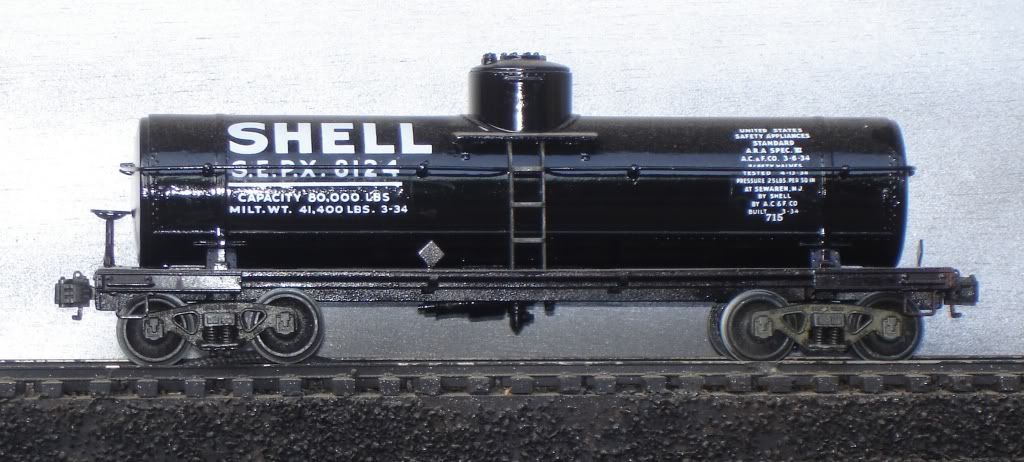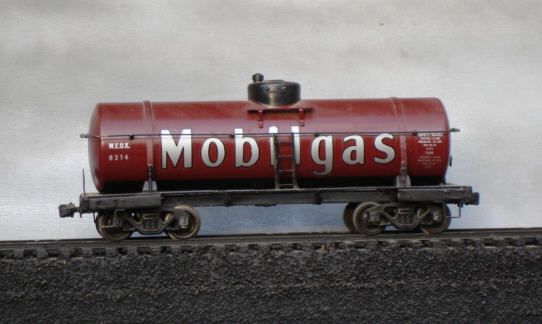Tank cars are among the most common and most interesting freight cars on North American railroads. They offer modelers a tremendous variety of shapes, sizes, construction techniques and paint schemes. They may also be the car type that is the least well understood by railfans and model railroaders. That due to the vast number of variations combined with the fact that most tank cars are privately owned and less comprehensive information on current and historical cars is available from common reference sources than for railroad owned cars. In this installment of the O Scale Freight Car Guide we will try to learn a little more about the basics of tank car construction and the commodities they carry as well as the models available on the O scale market today.
Car builders face a variety of challenges when designing and constructing tank cars. Some of the liquids carried in tank cars are lighter than water. Some are far heavier than water. Some are corrosive to steel and require special internal tank linings. Some are flammable. Some are highly toxic if leaked. Some don't want to be a liquid at all unless they are under high pressure or are heated to a high temperature. Because of these varying requirements many tank cars must be designed and built to carry specific types of materials. Tank cars have tended to become even more specialized over time. Today's tank cars are often designed to haul just one commodity and to be loaded to their maximum weight when carrying their full designed volume of that one product.
Let's take a look at O scale tank car models beginning with models of steam and early diesel era cars and progressing to models of more modern prototypes.
Steam and Early Diesel Era Tank Cars
Tank cars of the steam and early diesel era were typically constructed with riveted or welded tanks riding atop steel underframes. Tanks intended for non-pressurized liquids had domes to allow for the expansion of the product with an increase in temperature. Just as with modern cars, the tanks may have been uninsulated or had the tank covered with a layer of insulation protected by an outer steel jacket. And, like today's cars, the tanks may have been equipped with steam heating coils to allow the product to be warmed for unloading.
8000 gallon Tank Cars
Eight thousand gallon tank cars were very common from the early decades of the twentieth century through the 1960s. They were used to carry a wide variety of liquids. Cars intended for hauling crude oil or refined petroleum products required only 40 ton trucks and had too little volume to be loaded to maximum weight. Cars hauling caustic soda, a dense chemical commonly used in many industries, are a perfect weight and volume match with 50 ton trucks.
Lionel's first new highly detailed O scale tank car of the modern era debuted in the 2001 Volume 1 catalog. This 8,000 gallon car features a plastic tank and underframe. These cars have come with two versions of Lionel's Diecast plain bearing trucks. The early trucked versions weight just shy of 10 ounces.

Atlas added to their O scale product line by acquiring InterMountain tooling in 2004 and announced their improved version of An American Car & Foundry 8000 gallon tank car in November of that year. Atlas upgraded the all plastic construction of the original InterMountain model with a diecast underframe and their plain bearing diecast trucks. Atlas 8,000 gallon tank cars tip the scales at over 16 ounces in 3 rail configuration.

The Atlas model has a longer but narrower diameter tank than the Lionel model. The different tank shapes provide a subtle and prototypical visual contrast when the two types of cars are are run together.
11,000 gallon Tank Car
Atlas introduced their 11,000 tank car in October 2003. This transition era design is based on an American Car & Foundry 50 ton pressurized tank car prototype. They were used for the transportation of several gasses that liquefy at high pressure and low temperature including anhydrous ammonia, chlorine and propane. Liquefied Chlorine is heavier than water and was a perfect match for a 50 ton/11,000 gallon car. Ammonia and propane are lighter than water when in a liquid state and a full load by weight could not be carried in an 11,000 gallon car making them candidates for early replacement when larger cars came on the scene in the 1960s. The Atlas 11,000 gallon tank car weighs 17 ounces.

Modern Tank Car Models from the 90s
The pattern for the modern tank car was set by the Union Tank Car “Hot Dog” design of 1954. The Union HD design used all welded, domeless tank construction along with stub sills. With stub sill construction the tank itself transmits the pulling or pushing forces of the train while the short underframes at each end of the car transfer the weight of the tank to the trucks and hold the draft gear. This construction method saves weight that can be used to haul additional product. Stub sill cars have been the most common type of tank car constructed since the 1960s and their wide acceptance coincided with the advent of 100 ton (263,000 pound gross weight) freight cars.
Several O scale models have been introduced since 1990 to depict modern tank car construction practices with welded, domeless tanks and stub sills. Most of these models represent what are now medium sized cars. Their level of detail is typical of most O scale cars from the 1990s and they have frequently been used as a generic model to carry popular paint schemes. The capacities or commodities depicted by the decoration of these models may or may not closely match the car's type or overall dimensions. Recent versions have typically received upgraded trucks and couplers.
Lionel added the Uni-Body tank car to the Standard O freight car offerings in 1990. The earliest cars have plain bearing trucks. Recently produced unibody tank cars have Lionel's excellent roller bearing trucks with rotating caps.

MTH introduced the first Premier a tank car 1996. They received updated trucks in the mid 2000s.

MTH followed up with the Premier line 8000 gallon tank car in the Spring 1997 catalog. It depicts a modern car designed to haul what are now considered small quantities of specialty chemicals. Like the rest of the premier line they received updated trucks in the mid 2000s.

K-Line produced tank cars with extruded Aluminum bodies in two different tank diameters, 2 and 2 1/4 inches. The cars with 2 1/4 inch diameter tanks were made in four lengths. The aluminum tank cars have continued in production under the K-Line by Lionel banner.

Weaver produced modern style tank cars advertized as 40 and 50 footers. A 40 footer with Weavers diecast three rail trucks tips the scale at 13 ounces.

Modern Tank Car models of specific prototypes
Since the late 1990s a large number of O scale car models have come on the market depicting modern freight cars. Several of these are tank car models of specific prototypes. They represent a wide variety of cars built for several types of service.
Atlas introduced their model of an ACF built 33,000 gallon propane tank car when they reentered the O scale market in the late 1990s. Like its companions in the Atlas Master Line it raised the bar for fidelity to the prototype and helped to change the O scale market.

MTH responded with their own model of a 33,000 gallon tank car in the 1998 Volume 3 catalog. While it is a less detailed model than the Atlas car it offers full scale dimensions at a lower price. Recent versions have upgraded trucks.

MTH followed with a 20,000 gallon tank car in the 1999 Volume 2 catalog. It is a model of a four compartment car designed to economically carry smaller volumes of multiple products such as different grades of lubricating oils. They have come with new style trucks since the mid 2000s.

Lionel joined the modern specific prototype tank car movement with their model of the GATX Tank Train in their 2002 Volume 2 catalog. The Tank Train concept saves labor in loading and unloading at facilities where multiple car shipments are originated and terminated. Linking the tank cars together with semi-permanently connected hoses allows all the cars in a set to be loaded or unloaded via a single connection.

MTH introduced their highly detailed model of a modern Funnel flow tank car in their 2004 Volume 1 catalog. Funnel flow tank cars are constructed with a low point in the middle of the tank to facilitate complete unloading by gravity. Funnel flow tank cars are used for a variety of commodities including corn syrup and are very common on today's railroads. The MTH funnel flow tank car was one of the first MTH Premier line models to come with an underframe designed for easy conversion to Kadee couplers. It also received MTHs latest 3 rail trucks and is easily converted to two rail with MTH's aftermarket 2 rail trucks. In factory 3 rail configuration the weight is over 14 ounces.

Atlas brought their model of an ACF 17,360 gallon tank car to market in October 2004. These cars are used exclusively for the shipment of molecular chlorine. They have a 263,000 pound gross rail load like all nominal “100 ton” freight cars. The heavy tank construction required for this toxic pressurized cargo reduces the net weight of the product to 90 tons. These are commonly referred to in industry as 90 ton chlorine tank cars. The Atlas models weight over 20 ounces.

Atlas came out with a direct competitor to the MTH funnel flow car with their 17,600 gallon tank car in January 2007. It is based on a popular car from Trinity Industries.

Introduced in 2009, the Lionel 30,000 gallon ethanol tank car has been made in both Vision Line sound and command equipped or regular versions. All are fine models of tank cars used to serve the fuel industry today. They are very light for their size at less than 14 ounces for the non-sound version.

Atlas has announced a new model of a Trinity Industries 25,500 gallon tank car used for a variety of food, chemical and petroleum products.

As always, additional information or corrections are most welcome. And let's see your O scale tank cars!
For information on other types of freight cars see the O Scale Freight Car Guide thread here.
https://ogrforum.com/t...le-freight-car-guide



























